In 2019, cricket witnessed the farewell of several legendary players, who either retired from specific formats or stepped away from the sport altogether. Here’s a look at some of the most notable retirements from that year.
Yuvraj Singh

Yuvraj Singh, a two-time World Cup champion, announced his retirement from international cricket in June this year. Yuvraj, who last represented India in June 2017 during an ODI against the West Indies, enjoyed a distinguished 19-year international career, highlighted by victories in two World Cups: the inaugural ICC World T20 in 2007 and the 2011 ICC Cricket World Cup.
At 38, Yuvraj was named Player of the Tournament during India’s historic 2011 World Cup triumph, where they became the first team to win the tournament on home soil by defeating Sri Lanka in the final at Wankhede Stadium. Yuvraj had first burst onto the international scene as an 18-year-old during the 2000 ICC Knockout tournament in Kenya, where he made an immediate impact with a match-winning 84 against Australia in the quarter-finals, only his second ODI appearance.
Lasith Malinga

Lasith Malinga retired from One-Day Internationals after playing the first of three ODIs against Bangladesh in July. At 35, he concluded his career as Sri Lanka’s third-highest wicket-taker in ODIs, amassing 338 wickets in 220 matches. He trails only behind Muttiah Muralitharan, who took 523 wickets, and Chaminda Vaas, with 399. Malinga also made his mark as Sri Lanka’s leading wicket-taker at the 2019 World Cup, securing 13 wickets in seven innings.
Dale Steyn

Dale Steyn announced his retirement from Test cricket in August, closing a remarkable chapter in South African cricket. Having made his debut in December 2004, Steyn represented the Proteas in 93 Tests, claiming 439 wickets—the most by any South African fast bowler. At 36, Steyn’s final Test appearance came against Sri Lanka in February of the same year. Throughout his stellar career, he notched 25 five-wicket hauls and 5 ten-wicket hauls. His best bowling figures in a Test innings stand at 7/51, while his best match figures are 11/60.
Hashim Amla

After Dale Steyn, Hashim Amla became the next South African cricket icon to announce his retirement from international cricket, bringing an illustrious career to a close in October. With 18,623 international runs to his name, Amla is widely regarded as one of South Africa’s greatest batsmen. His career reached its peak in 2013 when he became the first player since Ricky Ponting to top both the Test and ODI batting rankings simultaneously.
In Test cricket, Amla retired as South Africa’s second-highest run-scorer, amassing 9,282 runs at an average of 46.64, just behind Jacques Kallis. His tally of 28 centuries is also second only to Kallis. Amla holds the distinction of being the only South African to score a triple century in Tests, achieving this feat with an unbeaten 311 against England in 2012 at The Oval. Named South Africa’s Cricketer of the Year twice, in 2010 and 2013, Amla’s legacy as one of the country’s finest cricketers is well secured.
Shoaib Malik

Shoaib Malik officially retired from ODI cricket following Pakistan’s commanding 94-run victory over Bangladesh in the 2019 ICC Cricket World Cup at Lord’s, London. Reports suggest that Malik had hoped to feature in Pakistan’s final group stage match, aiming for a farewell appearance. However, the team management chose to stick with the “winning combination” for the game. A former Pakistan captain, Malik completed his ODI career with 237 matches, amassing 7,534 runs and taking 158 wickets. His international career also included 35 Test matches and 111 Twenty20 Internationals for Pakistan.
Imran Tahir

South African legspinner Imran Tahir announced that the 2019 ICC Cricket World Cup would mark his final appearance in ODI cricket for his country. He expressed his desire to create more opportunities for emerging spinners in the 50-over format. Tahir concluded his ODI career with 173 wickets in 107 matches, despite South Africa’s disappointing World Cup campaign, where they finished second to last. In addition to his ODI success, Tahir also represented South Africa in 20 Test matches and 37 T20 Internationals.
JP Duminy

JP Duminy, another South African cricketer, also announced his retirement after the World Cup. Duminy made his ODI debut in 2004 against Sri Lanka in Colombo and played 199 ODIs throughout his career, including four ICC 50-over World Cups. He scored 5,117 runs at an average of 36.81, hitting four centuries and 27 fifties, with a career-best of 150 not out against the Netherlands in 2013. As a bowler, he claimed 69 wickets at an average of 45.55. In Test cricket, before retiring, Duminy played 46 matches, amassing 2,103 runs at an impressive average of 46.28, which included six centuries and eight fifties. However, he has expressed willingness to continue playing T20 internationals for South Africa.
Nuwan Kulasekara

Nuwan Kulasekara announced his retirement from international cricket in July, bringing an end to a distinguished career. A key figure in Sri Lanka’s triumph at the 2014 ICC World T20 in Bangladesh, Kulasekara finished with 313 international wickets across 263 matches in ODIs, Tests, and T20Is. He made his ODI debut in 2003 at the age of 21 during a home series against England, going on to play 184 ODIs, claiming 199 wickets at an impressive economy rate of 4.9. In T20Is, Kulasekara played 58 matches and took 66 wickets. His final appearance for Sri Lanka was an ODI against Zimbabwe in Hambantota, following his last T20I against Bangladesh. Kulasekara had retired from Test cricket in 2016, having played 21 Tests since his debut in 2005, taking 48 wickets. His last Test match was at Lord’s in 2014.
Mohammad Amir

Pakistani fast bowler Mohammad Amir announced his retirement from Test cricket in July, while stating he remains available for ODIs and T20Is. This unexpected decision ends a Test career spanning 36 matches from 2009 to 2019, during which Amir claimed 119 wickets at an average of 30.47.
Amir made his Test debut as a teenager in Sri Lanka, quickly making an impact with his left-arm pace and swing. In less than a year, at just 18, he became the youngest and fastest bowler to reach 50 Test wickets. However, his career took a sharp turn when he was implicated in a spot-fixing scandal during a Test at Lord’s in 2010. In 2011, after an ICC investigation, Amir was banned for five years and spent six months in a UK prison.
His ban was lifted in 2015, and Amir returned to international cricket in 2016. However, he struggled to regain his early Test form. In the 22 Tests he played after his return, Amir took 68 wickets at an average of 31.51, with just one five-wicket haul.

